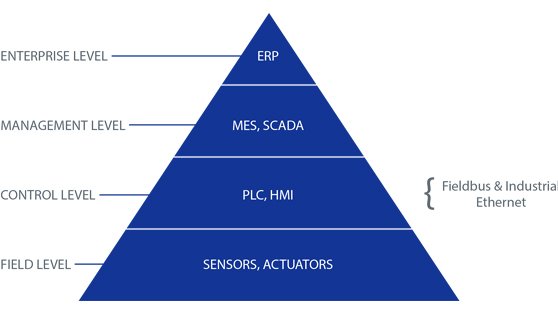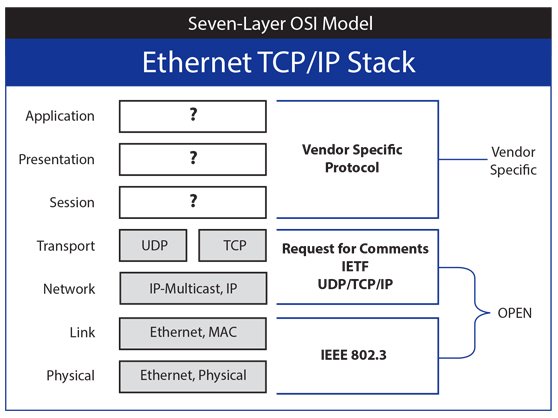Ethernet and the Importance of Network Connectivity
The concept of smart manufacturing, as we’ve mentioned, is predicted to be the next Industrial Revolution. And it is driven by connectivity and the unprecedented access to data. The data has always lived in your devices; it’s just become much easier to access and act on -- provided that you have network connectivity. A fully connected and enabled system, just like the interstate highway system, takes time to materialize. It takes vision and planning. It may require buying into smart functionality before you are fully able to utilize it. You begin a steady progression to replace aging devices with connected devices, installing the network along the way. It’s like investing in a roadway. If you wait until you need it, you will undoubtedly be too late.
Why Ethernet?
The world runs on Ethernet. Standards instilled years ago led to the rapid development of its technology, continued cost reduction, and adoption across multiple layers of applications. Ethernet provides the connectivity that is revolutionizing user experiences from the retail sector to healthcare. Ethernet was developed at Xerox in 1973. In 1983, the Institute of Electrical and Electronics Engineers (IEEE) issued a specification for Ethernet, supporting its growth with companies such as Intel and Digital Equipment Corp. During the mid-‘80s the Department of Defense began pushing standards that required interoperability between mainframes, resulting in IBM, Cray, Sun and others to begin rapid standardization of Ethernet and the TCP/IP protocol.
The Internet of Things (IoT) begins with connectivity on Ethernet. Devices are enabled to share information with both PCs and directly to each other. The options and access to new data is revolutionizing how we think about manufacturing. The market for industrial Ethernet applications is exploding, and was estimated to be worth nearly $1.48 billion in 2014 according to a report from IHS. Several options are coming to the marketplace, but all that’s necessary right now is that your technology is Ethernet-capable.
IHS’ estimated growth for industrial Ethernet products, which include gateways, switches, routers, wireless access points and connectors, is set at an 8.6 percent annual compound from 2013 to 2018. The installed base of Ethernet, combined with is ubiquitous use, is what drove major automation manufacturers, such as Rockwell Automation and Siemens, to develop an “industrial Ethernet.” But industrial applications vary in requirements, namely speed, and this has presented a significant challenge. There are more than 30 industrial Ethernet protocols available today, and each is racing to provide the best combination of speed, determinism and cost.
Ethernet basics and the challenges of industrial Ethernet
There are four basic levels of networks associated with automation systems:
- ERP level assimilates lower level information into an enterprise-wide view necessary for resource allocation, accounting, etc.
- MES and SCADA systems are associated with the operation and supervision of production operations.
- Control level networks are responsible for the process components associated with machine control, such as PLCs and HMI applications.
- The field or “fieldbus” level provides connectivity between devices such as sensors to control platforms like PLCs.
- The field bus layer can require response times as low as 100 mS, 10 mS, and less than 1 mS.
- This presents a real challenge for Ethernet, which was not physically designed for such speed and determinism.
- The term Ethernet describes the physical media of the network itself. The wiring and message components are defined by the network.
- How messages are processed, including flow control, prioritization, synchronization and error detection, is determined by the protocol. Ethernet can run several different protocols, including Modbus, HTTP and TCP/IP.

Ethernet topologies (physical design) include:
- Star, or hub and spoke. Higher performance, minimizing signal reflections.
- Provides wide-area multipoint connectivity.
- Trunk line. Bus type connection similar to DeviceNet. Introduces signal reflection, and there are limits of total number and collective length of drops.
Each topology has advantages and disadvantages. When considering performance it is also important to evaluate how data is transferred. A seven-layer model (ISO/OSI) is often used to describe the physical data layer and its relationship to protocol layers. The base layers (one and two) represent various types of networks from phone lines to Ethernet. Successive layers build toward the customization requirements of the application itself. [4]

Layer 7– Application
This layer defines what the data is (an Adobe file, an image) and makes the data “usable.” This layer works with the application software to facilitate communications and verify resources for data transfer.
Layer 6– Presentation
This layer provides data formatting to ensure that it is compatible between the application and lower layers. This layer may provide code conversion, data compression and encryption if necessary. It is typically not used in industrial networks.
Layer 5– Session
The session software provides authentication and authorization functions, including security and logging. It also manages the connection between the two communicating devices, establishing a connection, maintaining the connection, and ultimately terminating it. As in layer six, this layer is typically not used with industrial networks.
Layer 4– Transport
This layer provides quality of service (QoS) functions and ensures the complete delivery of the data. End-to-end integrity of the data is guaranteed at this layer via error correction and similar functions.
Layer 3– Network
The network layer provides for packet routing between nodes (addressing). It also provides services to break large messages into smaller packets (reassembling at destination).
Layer 2– Data Link
This layer is responsible for the physical transmission of data packets between nodes. A data packet includes a checksum, source and destination.
Layer 1– Physical
This layer defines the physical media, including the cabling, connections and other hardware for signal transmission (hubs/repeaters).
Layers one and two are “fixed” by the network. Layer 1 media is specified by standard, and layer 2 is typically managed by integrated circuit embedded in the hardware. The remaining layers are managed by software, either in the protocol or the application itself.
Manufacturers regularly invest in the development of industrially hardened Ethernet components, including connectors, cabling, switches and interface cards. But most of the performance enhancements can be made with the protocol itself, and out of the 30-plus available there are two you should be aware of.
Security is a final consideration, as Ethernet use continues to expand both horizontally and vertically in manufacturing facilities. The ease of connectivity with enterprise level systems introduces new issues that must be considered. Fortunately there are proven strategies to protect systems at both the plant floor level and in the layer between plant floor and enterprise systems.










